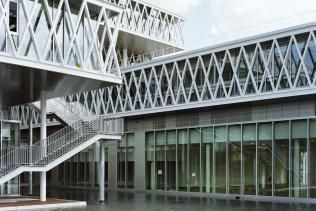 Pierrefitte-sur-Seine, despite the RN1, - national road, it has managed to preserve its green spaces and find a balance between pavilions and the renovated town-centre.
Pierrefitte-sur-Seine, despite the RN1, - national road, it has managed to preserve its green spaces and find a balance between pavilions and the renovated town-centre.
The name of the city comes from the Latin word "petra ficta", a long or standing stone, a Menhir or a marker to set boundaries. The existence of the village dates back from 862, the vineyards of the region were then allocated to the monks in the abbey of Saint Denis. The village remained under the sovereignty of the great abbey until the Revolution. In 1381, an uprising put an end to the culture of the vine and they were all ripped up by angry peasants. After that viticulture was largely replaced by wheat. The origin of this revolt remains obscure. During the Hundred Years Wars, Pierrefitte was burned and pillaged by the English. In 1649, the Fronde [a series of civil wars occurring in the midst of the Franco-Spanish War in France between 1648 and 1653], caused a lot of suffering. In 1725, the main road from Paris to Saint Denis was extended, running straight up to the entrance of the village, which made traveling easier. In 1757, the boundaries between Stains and Pierrefitte were set up and a trustee was charged to administrate the monuments and the assets of the Parish. One of the two registers of grievances in 1789 was written by Jean Baptiste Lardier.
It was at the revolution that the city began agricultural activities once again for less than a century. In 1790, the village was appointed head of the canton but this privilege was withdrawn in 1801. The end of the first empire was marked by the destruction of the town archives. In 1856, the city was served by the Creil railway line. The war of 1870 did not spare Pierrefitte which was occupied by the Prussians and the town was often bombarded, especially during the siege of Saint Denis. In the nineteenth century, the town of Pierrefitte became a resort for the Parisian Bourgeois.
Since the beginning of the twentieth century the city was urbanized, firstly through the southern area bordering Saint Denis. It was the Bretons who came to work at the Gas Company that built small houses in passage ways, down very narrow lanes. Fifteen percent of the area was devoted to private and public green spaces, administrated by urban law. Discover the chapel Notre-Dame de la Reconnaissance and church Saint-Gervais - Saint-Protais consecrated in 1857 on the site of an older foundation which was confirmed as having existed after 1599. The straight and wide church tower houses a bell offered by the Empress Eugenie in 1859.
Take a look at the Pierrefitte-Stains train and RER Station, built at the same time as the line from Paris to Creil in May 1859. Delivering local products to the markets in Paris made the town prosper. January 5, 1864, the station was the scene of one of the first major crashes in the history of railways where six people died and forty were wounded. The RER D has served the station Pierrefite-Stains since 1989.
The famous playwright, Frederick Lemaître (1800-1876) lived in Pierrefitte from 1830 to 1845 at number 2 Gazebo Street, now rue Etienne Dolet. He was a great friend of Honoré de Balzac and Théophile Gauthier, whom he frequently invited to his home. An aquarelle representing the three men can be viewed in the garden of the actor. The statue in Vornière square represents Lemaître in one of his most famous roles, that of Robert Macaire, in “Auberge des Adrets”. His character was evoked in Les Enfants du Paradis by Marcel Carné (1945). André Maurois said about him: "performed by him, melodrama was transformed into revolutionary comedy and became a social fact." To enjoy fresh air, you have the choice of green spaces in the town: Parc de la République, avenue de la République; Parc Nelson Mandela; and in the center of the city; Parc Frédérick-Lemaître, rue Etienne-Dolet, Square Vornière boulevard Charles-de-Gaulle.
For fresh air, there's a wide choice of green spaces: Parc de la République, avenue de la République; Parc Nelson Mandela in the city center; Parc Frédérick-Lemaître, rue Etienne-Dolet, Square Vornière boulevard Charles-de-Gaulle, Parc de la Butte-Pinson.
In 2013, the French National Archives moved to Pierrefitte. Exhibitions, tours and other events are held here regularly. The site is also worth a visit for its architecture and works of art.
The Flora Tristan media library is open on Monday afternoons (except during school vacations). The town also boasts a cultural center, the Espace Maurice Utrillo, offering exhibitions, outings, workshops and an art library.
May 21, 2022: inauguration of the Claire Supiot swimming pool (rue Utrillo).
Remember to book a hotel in the town or close to Pierrefitte. You can also take a look at the selection of restaurants located in this small town. For further information, refer to the official website of the town. Pierrefitte-sur-Seine is part of Plaine Commune urbain community.